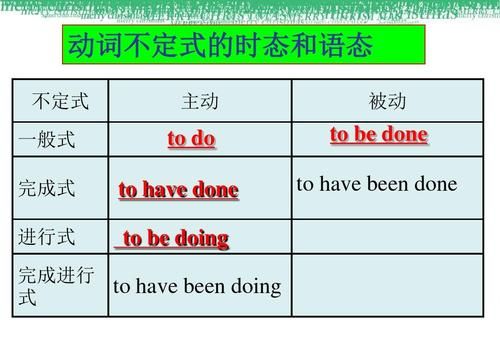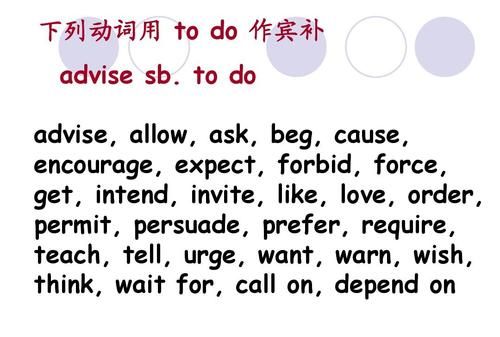本文目录
be about to do 表将来的用法
be to do共有八种用法:表示坚决的命令、表示“计划”或“安排的事项”、表示“可能性”、表示“意图”、表示“应该”、表示“注定”“不可避免”“必然发生”、用于虚拟语气,表示一种假设、有“期待将来”的含义。
1、表示坚决的命令,可译为“必须”。
(1)This naughty boy is to stay here until the class is over.这个淘气的男孩必须在这里站到下课。
(2)No one is to enter this building without the permission of the security guard.未经保安人员的允许,任何人都不得进入这栋楼。
2、表示“计划”或“安排的事项”。
(1)Betty is to be married soon.贝蒂很快就要结婚了。
(2)An insurance agent is to meet us this afternoon.今天下午会有一个保险代理人来跟我们见面。

do的详解:
“do”具有多种词性和词义,有 做、干、进行、表现,的确 等意思。
do用作动词,即可用作及物动词也可用作不及物动词,可接名词、代词、动名词、从句作宾语,也可接同源宾语; 还可接双宾语;用作名词时表示注意事项,聚会等含义。
例句:He does nothing but eat and drink。
他除了吃喝之外,什么也没做。
初中英语to do sth.句型
请看下面的试题:
He knows nothing about it, so he can’t help _________ any of your work.
A. doing
B. to do
C. being doing
D. to be done
【分析】此题答案应选B。比较以下结构:
can’t help to do sth = 不能帮助做某事
can’t help doing sth = 禁不住做某事,情不自禁地做某事
请看例句:
I can’t help to do it. 我不能帮忙做这事。
He couldn’t help to wash the clothes. 我不能帮忙洗衣服。
She couldn’t help smiling. 她禁不住笑了起来。
She couldn’t help envying Helen. 她不由得不妒忌海伦。
We cannot help being impressed by their zeal. 我们不由得不被他们的热情感动。
英语有时还可说can’t help somebody doing something不能使某人不做某事。如:
I couldn’t help him saying that. 我不能让他不这样说。
We couldn’t help them seeing us. 我们无法让他们不看到我们。
She could not help the tears of rage rolling down her face. 她止不住她愤怒的眼泪顺着面颊流下来。
又如下面一题,答案也是 B:
She can’t help _________ the house because she’s busy making a cake.
A. cleaning
B. to clean
C. cleaned
D. being cleaned
再请看以下试题:
While shopping, people sometimes can’t help _________ into buying something they don’t really need.
A. to persuade
B. persuading
C. being persuaded
D. be persuaded
此题应选C,句中的 can’t help 意为“禁不住”(注意根据句意用被动形式)
使用-ing的几种情况
(一)在进行时态中。如: 1.He is watching TV in the room.
2.They were dancing at nine o'clock last night.
(二)在there be结构中。
如:There is a boy swimming in the river.
(三在have fun/problems结构中。
如:We have fun learning English this term.
They had problems getting to the top of the mountain.
(四).在介词后面。如:Thanks for helping me.
Are you good at playing basketball?
What /How about doing sth? 做某事怎么样? I am interested in playing football.
(五).在以下结构中的应用:
1. enjoy doing sth 喜欢做某事;
2. finish doing sth; 完成做某事;
3. feel like doing sth 想要做某事;
4. stop doing sth 停止做某事(原来的事)
5. forget doing sth 忘记做过某事;
6. go on doing sth 继续做某事(原来的事);
7. remember doing sth 记得做过某事;
8. like doing sth 喜欢做某事;
9. find /see/hear/watch sb doing
发现/看到/听到/观看某人做
10. try doing sth 试图做某事;
11. need doing sth 需要做某事;
12. prefer doing sth 宁愿做某事;
13. mind doing sth 介意做某事;
14. miss doing sth 错过做某事;
15. practice doing sth 练习做某事;
16. be busy doing sth 忙于做某事;
17. can't help doing sth 禁不住做某事;
18. waste time/money doing 浪费时间/金钱做…
19. keep sb.doing让…始终/一直做…
20. stop sb.(from)doing 阻止某人做某事
21. prefer doing B to doing B=like A better than A
喜欢做A更喜欢做B
22. “do some +doing”短语
do some shopping do some washing
do some reading do some practicing
do some cleaning do some speaking
23.“go doing”短语去做某事(主要指文娱活动等)
go shopping go fishing
go swimming go hiking
go skating go camping
go skiing(滑雪) go boating
go hunting (打猎)
.注意动词的过去分词的常见搭配:
I feel(am/was) excited/ surprised/ amazed /interested /tired/pleased/worried/lost
Keep…closed/ a boy called/named Tom
常见动词不定式词组、句型用法
固定用法(非谓语动词):
以下是带to的动词不定式
★希望做某事hope to do sth.
★决定做某事decide to do sth.
★同意做某事agree to do sth.
★需要某人做某事need to do sth.
★使用某物做某事use sth to do sth
★迫不及待做某事can’t wait to do
★准备做某事get/be ready to do
★尽力/努力做某事try to do sth
★计划做某事plan to do sth.
★不得不have to do
★轮流做某事take one’s turns to do sth.
★拒绝做某事refuse to do sth.
★告诉某人做某事tell sb. to do sth.
★请某人做某事ask sb. to do sth.
★希望某人做某事wish sb. to do sth.
★想要某人做某事want /would like sb. to do sth.
★同意某人做某事agree sb. to do sth.
★教某人做某事teach sb. to do sth.
★喜欢/想要某人做某事 like sb. to do sth.
★帮助某人做某事help sb. to do sth/help sb.do
★鼓励某人做encourage sb to do
★It’s one’s turn to do sth. 轮到某人做某事 例句:It your turn to clean the blackboard.
★It’s time(for sb.) to do sth.是某人做某事时候了 例句:It’s time for me to go home.
★It’s +adj. for/of sb. to do sth. 对于某人来说做某事是……(当adj.是表示性格、品德的形容词时用of)
例句: It is easy for me to learn it well.
It is very kind/foolish/nice of you to do so.
★ It takes sb. sometime to do sth.
某人做某事花了某时间
例句:1.It takes me an hour to get to school by bike.
2.It took me an hour to watch TV last night.
3.It will take her two weeks to finish the work.
★too+adj./adv. to do sth. 太…..而不能 例: He was to angry to say a word.
★find/think/feel it +adj. to do sth.发现/认为/感到做某事是…
例: I find/think/feel it hard to learn English well.
★序数词+to do 第…..个做某事 例句:
Who is the first to get there?
★我不知/忘记了怎么办。
I didn't know/forgot what to do.
★ 离开房间时不要忘记/记住关灯
例句:Don’t forget/Remember to turn off the lights when you left the room
★ be+adj+to do sth
例句:I am very sorry to hear that.
I am ready to help others.
I am happy/pleased/glad to meet you.
顺口溜:本领最多不定式,主表定补宾和状;样样成分都能干,只有谓语它不敢;大家千万要小心,有时它把句型改;作主语时用it,自己在后把身藏;七个感官三使役,宾补要把to甩开;疑问词后接上它,宾语从句可充当;逻辑主语不定式,不定式前加for sb.;to前not是否定,各种用法区别开。
以下是不带to的动词不定式(即动词原形)的常见用法
★ let sb. do sth让某人做某事
★ make do sth使得某人做某事
★ hear do sth do sth听见某人做某事
★see do sth do sth看见某人做某事
★ why not 或why don’t you +动词原形?为什么不….?(表示建议)
例:Why not/Why don’t you take a walk?
★ 某人+had better( not)do 某人最好(不)做某事
★ 情态动词can/may /must /should+ 动词原形(包括情态动词的否定形式+动词原形)
★ 助动词do/does/did/will/would在构成疑问句或者构成否定句即don’t /doesn’t /didn’t /will not /would not+ 动词原形
★ be going to + 动词原形(表示“即将”“打算” 做某事)

to do不定式的用法及举例
有
to do一般是指动作将要发生还没发生
I have a lot of homework to do
我有很多家庭作业要去做
呵呵,有疑问可以追问

to do不定式做后置定语的几种情况
1、只能以不定式作定语的名词:ability、anxiety、attempt、curiosity、decision、desire、disposition、failure、freedom、inclination、obligation、offer、permission、plan、promise、refusal、reluctance、temptation、tendency、willingness、wish、yearning等表示愿望、企图、打算、能力等意义的词。
例:Their decision to leave was very annoying.=Their decision that they decided to leave was very annoying. 他们要走的决定叫人心烦。
2、修饰的名词前有the only,the next,the best,the first、the last以及有序数词或形容词最高级修饰的名词时,用不定式作后置定语。
例:He was the first one to think of the idea. 他是第一个想到这一点的人。
3、修饰的词语是something、nothing、anything等不定代词时,只能用不定式作后置定语。
例:There is nothing to worry about. 没什么需要担心的事情。
4、当定语表示的是将来要做的事情时,要用不定式作后置定语。
例:The letter to be written is to my father. 这封即将要写的信是写给我爸爸的。

5、当被修饰的名词或代词与定语之间有动宾关系时,被修饰的名词或代词是动词不定式的逻辑宾语,用不定式作后置定语。可改成定语从句。
例:This is a delicious cake for you to eat.=This is a delicious cake for you which you can eat.这是一个给你吃的美味蛋糕。
6、 当被修饰的名词或代词与定语之间有主谓关系时,不定式的动作是不定式所修饰的名词或代词来执行。
例:He was a brave man to do what he did.=He was a brave man who could do what he did. 他是个敢做敢当的勇敢之人。
7、不定式跟中心词有同位关系,这类名词一般都只能用不定式作定语。
(1)某些由同源动词转变而来的名词,同源动词以不定式做宾语,同源名词则以不定式做定语,不定式跟中心词是同位关系。(名词见第1条)
(2)某些以不定式作状语的形容词,派生转化为同源名词后,也可以用不定式作定语。不定式跟这个名词中心词也是同位关系。在这种结构中,不能用分词形式。
例:Her anxiety to succeed led her to workhard.她迫切想成功,这促使她努力工作。
8、被修饰的中心词和不定式之间有状语关系,被修饰的中心词接上适当的介词可以看成是不定式的状语。
(1)修饰某些抽象名词的不定式,也可以使用介词接动名词的方式。这类名词通常表示抽象概念,后面用动词不定式做定语,解释中心词的内容。
这样的名词有如:ambition, campaign, chance, honor, mood, need,necessity, plan, opportunity, reason, right, time, way等。
例:Give me your reasons to go/for going there.告诉我你去那儿的理由。
(2)不及物动词加介词的不定式做定语,可以改成:preposition + whom/which +to do结构。
例:Please give me a seat to sit on/on which to sit.请给我一条凳子坐坐。
以上就是关于to do不定式表将来例句 ,be about to do 表将来的用法的全部内容,以及to do不定式表将来例句 的相关内容,希望能够帮到您。
